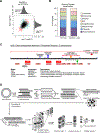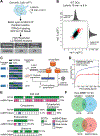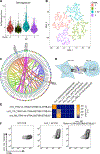Antigen discovery and specification of immunodominance hierarchies for MHCII-restricted epitopes
- PMID: 30349087
- PMCID: PMC6312190
- DOI: 10.1038/s41591-018-0203-7
Antigen discovery and specification of immunodominance hierarchies for MHCII-restricted epitopes
Abstract
Identifying immunodominant T cell epitopes remains a significant challenge in the context of infectious disease, autoimmunity, and immuno-oncology. To address the challenge of antigen discovery, we developed a quantitative proteomic approach that enabled unbiased identification of major histocompatibility complex class II (MHCII)-associated peptide epitopes and biochemical features of antigenicity. On the basis of these data, we trained a deep neural network model for genome-scale predictions of immunodominant MHCII-restricted epitopes. We named this model bacteria originated T cell antigen (BOTA) predictor. In validation studies, BOTA accurately predicted novel CD4 T cell epitopes derived from the model pathogen Listeria monocytogenes and the commensal microorganism Muribaculum intestinale. To conclusively define immunodominant T cell epitopes predicted by BOTA, we developed a high-throughput approach to screen DNA-encoded peptide-MHCII libraries for functional recognition by T cell receptors identified from single-cell RNA sequencing. Collectively, these studies provide a framework for defining the immunodominance landscape across a broad range of immune pathologies.
Conflict of interest statement
Competing Financial Interests Statement
The authors declare no competing financial interests.
Figures






Similar articles
-
Predicting CD4 T-cell epitopes based on antigen cleavage, MHCII presentation, and TCR recognition.PLoS One. 2018 Nov 6;13(11):e0206654. doi: 10.1371/journal.pone.0206654. eCollection 2018. PLoS One. 2018. PMID: 30399156 Free PMC article.
-
A novel approach of direct ex vivo epitope mapping identifies dominant and subdominant CD4 and CD8 T cell epitopes from Listeria monocytogenes.J Immunol. 2001 Feb 1;166(3):1877-84. doi: 10.4049/jimmunol.166.3.1877. J Immunol. 2001. PMID: 11160235
-
Multiple synergizing factors contribute to the strength of the CD8+ T cell response against listeriolysin O.Int Immunol. 2006 Jan;18(1):89-100. doi: 10.1093/intimm/dxh352. Epub 2005 Nov 15. Int Immunol. 2006. PMID: 16291651
-
Antigen-presenting cells and the selection of immunodominant epitopes.Crit Rev Immunol. 1997;17(5-6):411-7. Crit Rev Immunol. 1997. PMID: 9419428 Review.
-
Selection of immunodominant epitopes during antigen processing is hierarchical.Mol Immunol. 2019 Sep;113:115-119. doi: 10.1016/j.molimm.2018.08.011. Epub 2018 Aug 24. Mol Immunol. 2019. PMID: 30146122 Free PMC article. Review.
Cited by
-
Repertoire-scale determination of class II MHC peptide binding via yeast display improves antigen prediction.Nat Commun. 2020 Sep 4;11(1):4414. doi: 10.1038/s41467-020-18204-2. Nat Commun. 2020. PMID: 32887877 Free PMC article.
-
pH sensing controls tissue inflammation by modulating cellular metabolism and endo-lysosomal function of immune cells.Nat Immunol. 2022 Jul;23(7):1063-1075. doi: 10.1038/s41590-022-01231-0. Epub 2022 Jun 6. Nat Immunol. 2022. PMID: 35668320 Free PMC article.
-
Advances in nanocarrier-mediated cancer therapy: Progress in immunotherapy, chemotherapy, and radiotherapy.Chin Med J (Engl). 2025 Aug 20;138(16):1927-1944. doi: 10.1097/CM9.0000000000003703. Epub 2025 Jun 23. Chin Med J (Engl). 2025. PMID: 40545573 Free PMC article. Review.
-
Typical gut indigenous bacteria in ICR mice fed a soy protein-based normal or low-protein diet.Curr Res Food Sci. 2021 Apr 24;4:295-300. doi: 10.1016/j.crfs.2021.04.001. eCollection 2021. Curr Res Food Sci. 2021. PMID: 33997796 Free PMC article.
-
Recent Advances in Cancer Vaccines: Challenges, Achievements, and Futuristic Prospects.Vaccines (Basel). 2022 Nov 25;10(12):2011. doi: 10.3390/vaccines10122011. Vaccines (Basel). 2022. PMID: 36560420 Free PMC article. Review.
References
-
- Babbitt BP, Allen PM, Matsueda G, Haber E & Unanue ER Binding of immunogenic peptides to Ia histocompatibility molecules. Nature 317, 359–361 (1985). - PubMed
-
- Stern LJ, et al. Crystal structure of the human class II MHC protein HLA-DR1 complexed with an influenza virus peptide. Nature 368, 215–221 (1994). - PubMed
-
- Hsieh CS, deRoos P, Honey K, Beers C & Rudensky AY A role for cathepsin L and cathepsin S in peptide generation for MHC class II presentation. J. Immunol 168, 2618–2625 (2002). - PubMed
References for Methods
-
- Janeway CA Jr., et al. Monoclonal antibodies specific for Ia glycoproteins raised by immunization with activated T cells: possible role of T cellbound Ia antigens as targets of immunoregulatory T cells. J. Immunol 132, 662–667 (1984). - PubMed
-
- Zhu Y, Rudensky AY, Corper AL, Teyton L & Wilson IA Crystal structure of MHC class II I-Ab in complex with a human CLIP peptide: prediction of an I-Ab peptide-binding motif. J. Mol. Biol 326, 1157–1174 (2003). - PubMed
Publication types
MeSH terms
Substances
Grants and funding
LinkOut - more resources
Full Text Sources
Other Literature Sources
Research Materials

